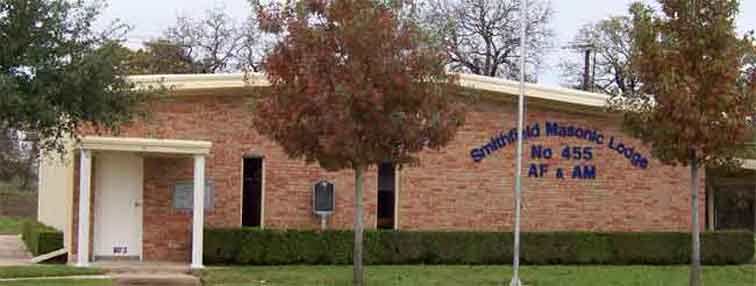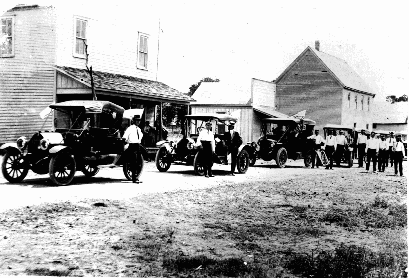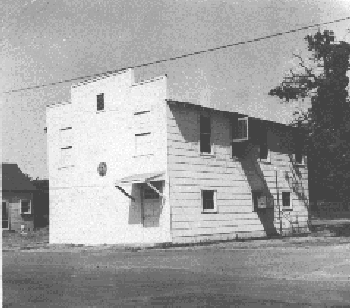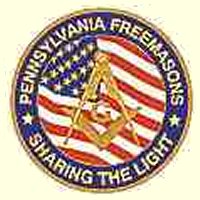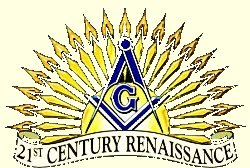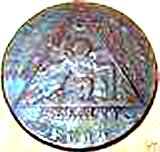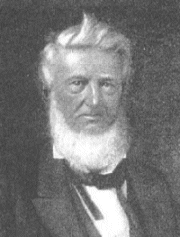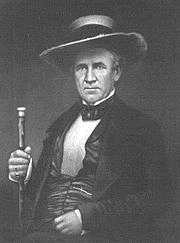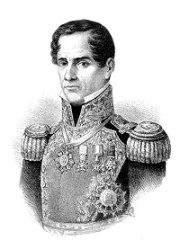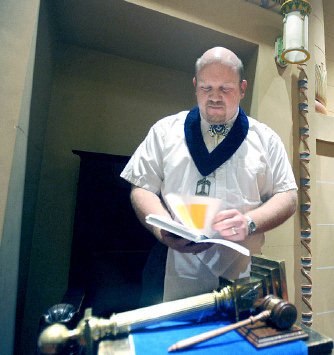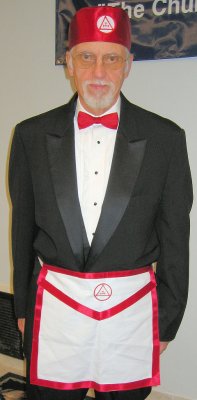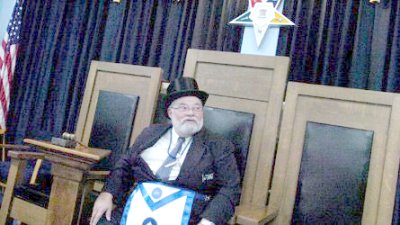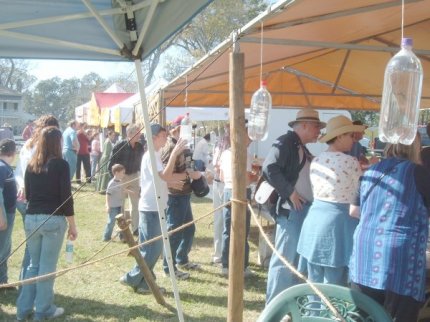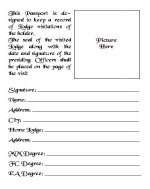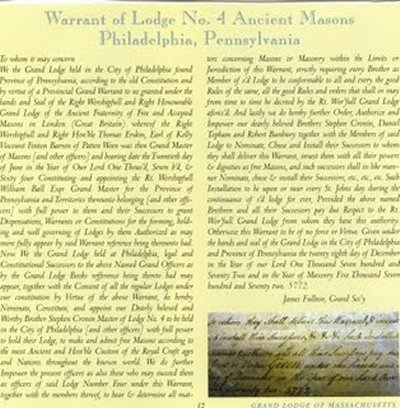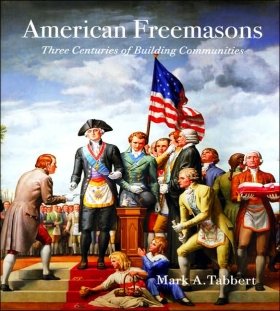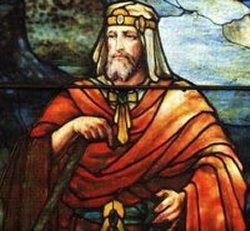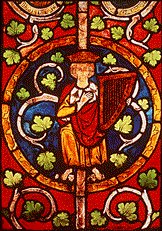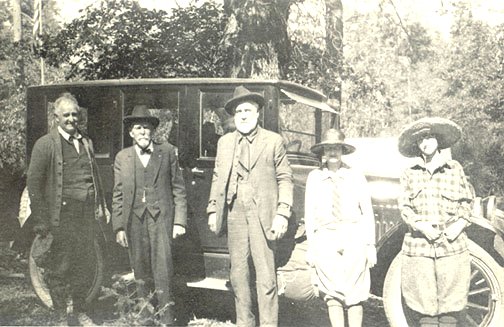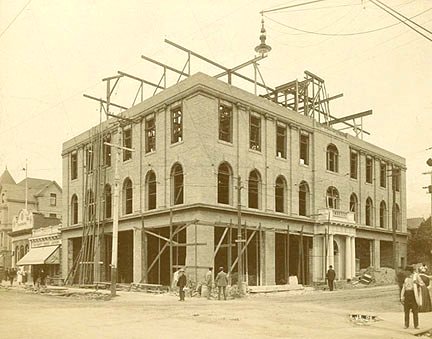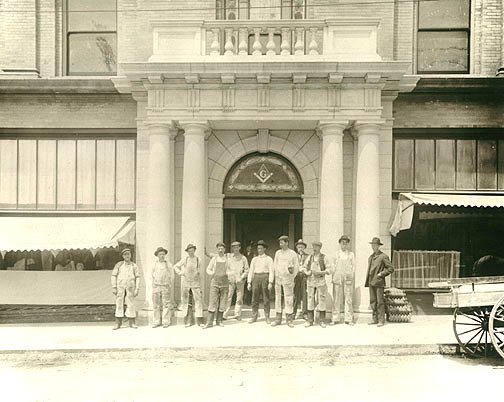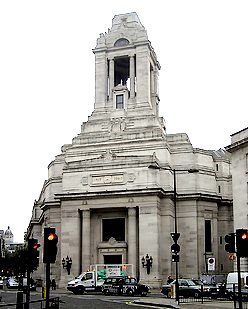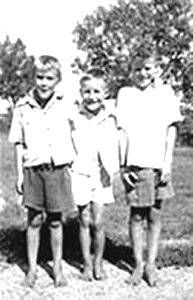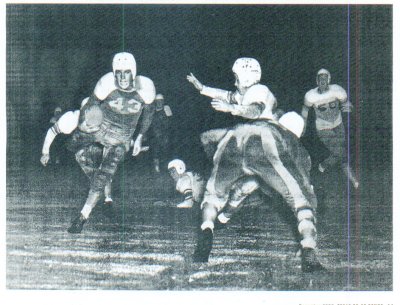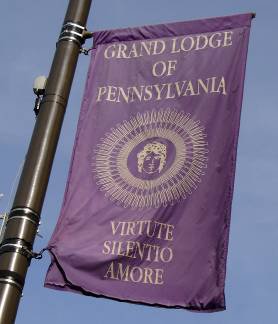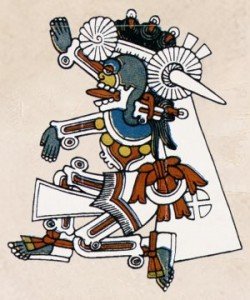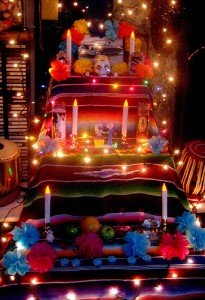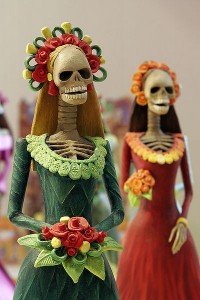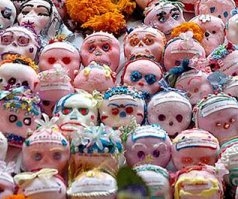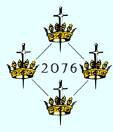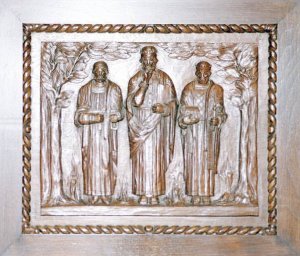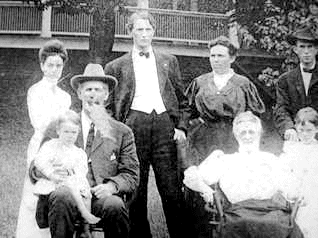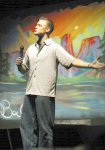
|
February 2010

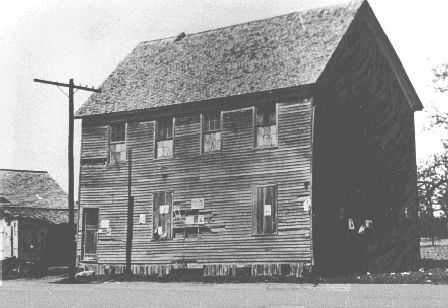
Smithfield Masonic Lodge #455 AF & AM
|
|
Page II | |||||||||
|
This Small Town Texas Mason's E-Magazine is not affiliated with any state Grand Lodge or individual Blue Lodge. It was created to enlighten, educate and entertain Masons and non-Masons alike. As title suggests, each issue will feature a small town Texas Masonic Lodge and some Texas Masonic history or hero in each issue The beliefs, ideas and opinions expressed here are strictly those of the authors and not necessarily those of the editor, any individual Blue Lodge or any state Grand Lodge.
A very sincere effort was made to avoid using any copyrighted material, without permission or giving credit to the author, in the creation of this web site. If you discover something that is yours, without giving you due credit, please let me know and due credit will be given or the item will be replaced.
Any material in this site may be used to increase the understanding of Freemasonry.
Story tools: |
Smithfield Masonic Lodge #455 AF & AM.
Does Pennsylvania Have A Clue?
Pennsylvania Masons Push Back Against Grand Master's Reforms
Big Changes at the Grand Lodge of Pennsylvania
General Houston's Account Of The Battle To President Burnett
Pop Fiction Gives Real Freemasonry A Boost
The Really Great Masonic Educational Web Sites Series
The Secret Society Series - The Second of Six
Fundraisers, Life In A Small Town Lodge
Document Discovery Sheds Light On First American Grand Lodge
Letters: What is a Mason anyway?
American Freemasons [A Book Review]
Bro William Wharff: Civil War Soldier and Architect.
Terra Incognita: The First Economic Peace In The Holy Land.
Masonic Music - Brethren Gather For Northern Celebration .
Boys And Girls From The Other Side Of The Park .
The Not-So-Secrets of the Temple.
Freemasonry and El Día de los Muertos (Day Of The Dead).
Masonic Lodge Celebrates Local Beginning.
The Birth of Free-Masonry; the Creation of a Myth Part 1 of 6.
Shrine of Thomas Harkins medals.
The Last Page - Odds and Ends.
| ||||||||
|
Editor's Notes: I have had a few emails that someone has an interesting Lodge history or story, but it wasn't a small town Lodge or it wasn't a Texas Lodge. This e-magazine features a small town Texas Lodge every month, BUT, I do include interesting stories about Lodges of any size or location when I discover them. Last month's issue, for instance, included a story about Lodge in London England and this month's has a story about a Lodge in Yellow Knife, Canada, so if you have something of interest, email it to me and I'll check it out. Photos do increase the value of a story. Also, if your Lodge has an online newsletter, I would really appreciate it if you would add me to the mailing list or forward them to me. I do enjoy reading about Freemasonry and Masons and what is going on in the Masonic world. And, I am always looking for interesting or unusual Mason stories for the magazine. Thanks, Corky |
|
Page IV | ||
Reprinted With Permission Of The Author
The goal of modernization and some of the steps taken is what Frank Haas did for West Virginia. It is my fervent hope that the succeeding Pennsylvania Grand Masters do not reverse all the changes Sturgeon has made or worse yet expel him for what he has done. Already we have the lines of battle drawn with a group of “traditionalists” rallying to reverse the reforms. It looks to me as if these changes were mandated by edict rather than submitted to a vote of the entire Grand Lodge membership. To pounce on Pennsylvania Freemasons with so many changes without allowing any input can be both a dangerous card to play and too much for the membership to digest in such a short period.
Over and above that most parties involved are not talking about the most important aspect of these changes, namely that which has been omitted. Rather the entire debate is focused on approval or disapproval of Sturgeon's 3Ms – Modernizing, Marketing and Membership. What Sturgeon and the rest of y'all have left out (HatRock excepted) is the need to have a membership committed to the principles of Freemasonry as a way of life, to be well grounded in the belief system of Freemasonry and to accept that as the foremost reason to be a Mason. Mainstream Masonry just hasn't learned yet that when you spend all your money, time and effort in marketing a product rather than on the product itself, then you end up marketing an inferior product. Short term the marketing works. But when dissatisfaction with the product sets in users and believers start to disappear. This holds true for any product. And that is why we have a retention problem. The performance of Freemasonry doesn't match its hype and what follows is apathy and disinterest.
The viability of Freemasonry has to rest on something solid, something that inspires and fires up the heart and soul, something that holds for the individual the very meaning and essence of life. Without that then the practice of Freemasonry becomes superficial and shallow.
An illustration of how important this is to most any organization can be illustrated by the plight of the Protestant Church. Those Protestant Churches labeled Mainline, such as Congregationalists, Methodists, Presbyterians, Lutherans, Episcopalians, etc. have seen their membership plummet in direct proportion to their deemphasizing doctrine and personal salvation, rather concentrating on social, community and political ends. Southern Baptists, Pentecostals, AME, Evangelicals, Black Baptists and a number of nondenominational communities who hold Bible Study, Prayer groups, mentoring and in depth and far reaching education from day one are strong congregations and are growing by leaps and bounds.
These more conservative and traditional Protestants are doctrine driven. Freemasonry should be doctrine driven, doctrine driven first. And then from that will flow the social, the community outreach and the fraternalism of fellowship. Belief must propel practice.
This way of looking at Freemasonry is often misunderstood. Such thinkers are not calling for some education in the Craft, they are calling for a focus of knowledge commitment.
I have sat in many a Mainstream Grand Lodge Session and watched the donations and money pour in. Yet Grand Lodge cannot place the outflow in its proper place with the proper priorities. Freemasonry is a bonding society. But the bonding needs to come from a sharing of the joy that emanates from an understanding of how Freemasonry changes the heart and inspires the nobleness in life. And that comes when the belief system of Freemasonry is ingrained in every Mason's heart and soul.
To these ends Lodges and Grand Lodges should be financing and leading Masonic
Lest any have forgotten this is The Information Age. Invest in Freemasonry to make it a superior product rather than an inferior one. Then watch it grow. It will sell itself. | ||
|
Big Changes at the Grand Lodge of Pennsylvania
Hot on the heels of the "21st Century Renaissance" rule changes announced by the Grand Lodge of Pennsylvania's
Grand Master Thomas K. Sturgeon reported on the preceding RL Newsletter page a website has been
launched that is pushing back.
The Pennsylvania Masonic Restoration website proclaims:
The Pennsylvania Masonic Restoration is a movement initiated and sustained by Pennsylvania Freemasons
who believe in the oaths they took to preserve and maintain our Masonic customs, ritual, landmarks and usages.
We believe that Pennsylvania Freemasonry is unique in the world and represents hundreds of years of
tradition and the hard work of millions of Freemasons. It should be preserved and passed down to future generations
of Freemasons as well preserved and maintained as it was for us.
To that end, we seek the restoration of our Masonic heritage. It is not our goal to challenge the authority of
the Right Worshipful Grand Master nor to interfere with the administrative functioning of the Grand Lodge of
Pennsylvania. We hold our oaths inviolable, including our requirement to support the Constitution and all
rules, edicts and/or resolutions that may be issued. It is our hope and our goal to see the recent detrimental
changes made to our ritual and customs repealed. Until that is accomplished, we seek to find ways for our
Pennsylvania Masonic Brethren to meet the conflicting challenge of obeying the directives of the Grand
Lodge and honoring the specifics of the oaths we took as Freemasons which directly contradict some of those
directives.
Rural Lodge Editor: Masons should indeed respectfully question Grand Lodge changes, although such objections may prove fruitless. Pennsylvania
Masons should also be aware of the groundswell of Masonic change that is washing around them, much of it initiated by the ideas emanating
from progressive Grand Lodges like GL Massachusetts.
.
. |
|
Page V | ||
|
Freemasonry in the Keystone State has always been strict as far as their practices go. No written rituals—all work is mouth to ear, and the W?M? does almost all of the speaking in all three degrees. Pennsylvania has rarely succumbed to one day classes, and never allowed even limited solicitation.
Well, much of that is changing this year. R?W?B? Thomas K. Sturgeon, Grand Master for 2010/2011 has announced an ambitious slate of changes for the upcoming year, under the aegis "21st Century Renaissance."
· Selective invitations allowed
There is much more, and the entire program can be read here. This is the most formidable outline of reforms and changes I have ever seen a grand master propose all at one toss. I am sure there will be grumbling across Pennsylvania, but Grand Master Sturgeon and his fellow officers have obviously been thinking long and hard about ways to face the challenges all jurisdictions are confronting.
The "Laudable Pursuit" generation of grand lodges officers are moving into the top positions all over the country, and are at last making the changes needed to adapt to the new century. In case you think Freemasonry never changes, we are living through a momentous time in the fraternity, with greater experimentation going on than at any other moment in history. Power is being devolved to the lodges, and grand lodges are removing barriers to new methods of holding meetings, teaching, learning and operating.
We live in exciting times. I'll be curious to see the reaction of Pennsylvania brethren.
. | ||
|
The Master of the Royal Mint was paid commission on the value of the Mint's output, so it was more profitable to produce gold and silver coins of higher denominations, even though the shortage of small change made local trading almost impossible. .
The upper classes also thought it demeaning to have the effigy of the monarch on base metal coins such as bronze or tin. So, in 1787, one Thomas Williams began minting his own token pennies and halfpennies from the copper he produced in his own mines in Anglesey. Soon, others imitated him, and subsequently even small traders and institutions were designing and producing their own token coins. More than 10,000 different designs appeared between 1787 and 1817, some in vast quantities. .
Among the many traders issuing tokens was James Sketchley, a bookseller and a Mason of Birmingham, who designed and issued the coin illustrated, the Masonic halfpenny. These were issued in 1794, probably as "Pocket Pieces" or curios, but it is certain that they were circulated widely and accepted as money in the same way as all the other token coins. It is not recorded how many were made, but experts have recognised three different dies for one face, two for the other and 13 edge inscriptions, so it is fair to assume that very many were produced.
After a short time, the manufacture was taken over by William Lutwyche, another Mason. The top illustration of the coin is depicted what may be termed its historical face. It carries the Mason's Arms, the insignia of the Premier Grand Lodge, which Brother Sketchley's Lodge, St Paul's, now No. 43, had adopted as its crest in 1786. There are several noteworthy points. First, the escutcheon or shield is divided by a chevron, on which is engraved wideopen compasses. Second, two beavers, traditionally famed for their industry, support the shield. Third, above the shield is a globe surmounted by the Dove of Peace, and finally, the legend Amor, Honor et Justitia – Love, Honor and Justice.
Around the circumference is an inscription commemorating the election in 1790 of HRH the Prince of Wales as Grand Master of the Premier Grand Lodge, referred to as "The Moderns". The Prince of Wales subsequently became Prince Regent, and later King George IV.
The bottom illustration I deem the symbolic or allegorical face of the coin. First, the Latin legend Sit Lux et Lux fuit – Let there be light and there was Light. Also, observe around a triangle the names of those three great pillars that symbolically support a Lodge: wisdom, strength and beauty.
Finally, observe the shape of this coin, a perfect circle, a line with no beginning and no end, signifying Charity, reminding us that the Great Architect has ruled, is ruling now, and will continue to rule till time shall be no more.
This Masonic Token is a coin of small value, and yet as an object on which to moralise is of inestimable worth. It provides a direct link with our brethren of over 200 years ago, and illustrates the stability and unchanging nature of our peculiar system of morality that is amply illustrated by such symbols.
This article is based on a lecture delivered by the late W Bro Fred Finedon to his own lodge, Babergh Lodge No 8122 and to the Lodge of Perfect Friendship No 376.. |
|
Page VI | ||||||
"General Houston's Account Of The Battle To President Burnett
To his
Sir,
The Army was ordered to be in readiness to march early on the next morning. The main body effected a crossing over Buffalo Bayou, below Harrisburg on the morning of the 19th, having left the Baggage, the sick, and a sufficient camp Guard in the rear. We continued the march throughout the night, making but one halt in the prairie for a short time, and without refreshment-At daylight we resumed the line of march, and in a short distance our Scouts encountered those of the Enemy, and we received information that Gen Santa Anna was at New Washington and would that day take up his line of march for Anahuac, crossing at Lynch's. The Texian Army halted within half a mile of the Ferry in some timber, and were engaged in slaughtering beeves, when the army of Gen Santa Anna was discovered to be approaching in battle array, having been encamped at Clopper's point eight miles below- Disposition was immediately made of our forces, and preparation for his reception - He took a position with his Infantry & Artillery in the center occupying an island of timber- his cavalry covering the left flank. Their artillery then opened upon our Encampment, consisting of one double fortified medium brass twelve pounders - The Infantry in columns advanced with the design of charging [our lines] but were repulsed by a discharge of grape and canister from our artillery, consisting of one double fortified two six pounders. The Enemy had occupied a piece of timber within rifle shot of the left wing of our Army, from which an occasional interchange of small arms took place between the troops, until the Enemy withdrew to a position on the bank of the San Jacinto, about three quarters of a mile from our Encampment and commenced a fortification - A short time before sunset our mounted men, about Eighty five in number, under the special command of Col. Sherman, marched out for the purpose of reconnoitering the Enemy. Whilst advancing they received a volley from the left of the Enemy's Infantry, and after a sharp encounter with their cavalry, in which ours acted extremely well and performed some feats of daring chivalry, they retired in good order having had two men severely wounded, and several horses killed, in the mean time the Infantry under the command of Lieut Col. Millard and Col. Burleson's regiment, with the Artillery had marched out for the purpose of covering the retreat of the Cavalry, if necessary; all then fell back in good order to our Encampment about sunset, and remained without any ostensible action until the 21st at ½ past 3 o'clock, taking the first refreshment which they had enjoyed for two days. The Enemy in the mean time, having extended the right flank of their Infantry so as to occupy the extreme points of a skirt of timber on the bank of the San Jacinto and secured their left by a fortification about 5 feet high, constructed of packs and Baggage, leaving an opening in the center of the Breastwork in which their Artillery was placed. Their Cavalry upon their left wing.
Our line advanced without a halt, until they were in possession of the woodland and the Enemy's breastwork. The right wing of Burleson's and the left of Millard's taking possession of the breastwork our artillery having gallantly charged up within 70 yards of the Enemy's cannon, where it was taken by our troops. The conflict lasted about 18 minutes from the time of close action, until we were in possession of the Enemy's [encampment] taking [one] piece of cannon (loaded), 4 Stand of colors, all their camp equipage, stores, and Baggage. Our cavalry had charged and routed that of the Enemy upon the right and given pursuit to the fugitives, which did not cease until they arrived at the bridge which I have mentioned before. Capt Karnes, always among the foremost in danger commanding the pursuers. The conflict in the breastwork, lasted but a few moments; many of the troops encountered hand to hand, and not having the advantage of bayonets on our side, our riflemen used their pieces as war clubs, breaking many of them off at the breech. The route commenced at ½ past 4, and the pursuit by the main army continued until twilight. A guard was then left in charge of the Enemies Encampment, and our army returned with our killed and wounded. In the Battle our loss was two killed and twenty three wounded, six of whom mortally. The Enemy's loss was 630 killed, among which was one General Officer, 4 Cols. 2 Lieut Cols. 5 Captains-12 Lieuts. Wounded: 208 of which were 5 Cols, 3 Lieut cols, 2 Second Lieut Cols, 7 Captains- 1 Cadet. Prisoners: 730. President General Santa Anna, Gen. Cos, 4 Cols aids to Gen Santa Anna, 6 Lieut cols. the private Secretary of Gen Santa Anna, and the Col of the Guerrero battalion are included in the number. Gen Santa Anna, was not taken until the 22nd, and Gen Cos on yesterday; very few escaped. About 600 muskets-300 Sabers, and 200 pistols have been collected since the action. Several hundred mules and Horses were taken, and near twelve thousand dollars in specie-
I have the honor of transmitting herewith a list of all the officers and men who were engaged in the action, which I respectfully request may be published as an act of justice to the individuals. For the Commanding Generals to attempt discrimination as to the conduct of those who commanded in the action, or those who were commanded would be impossible. Our success in the action is conclusive proof of their daring intrepidity and valor; every officer and man proved himself worthy of the cause in which he battled, while the triumph received a luster from the humanity which characterized their conduct, after victory, and richly entitles them to the admiration and gratitude of their General. Nor should we withhold the tribute of our grateful thanks, from that Being who rules the destinies of nations and has in the time of [greatest] need enabled us to arrest a powerful invader whilst devastating our Country. |
|
Page VII | ||
By Mark Barna
So why would anyone label the Freemasons a cult?
Maybe it has to do with members’ mystery-shrouded rituals that include secret passwords and initiations, their use of arcane symbols and their penchant for bestowing such exotic titles as “Entered Apprentice” upon its members.
Maybe it’s because of a historically rocky relationship with the Catholic Church, which reinforced a prohibition against the faithful becoming Masons with this 1983 declaration from then-Cardinal John Ratzinger: “Catholics who join the Masons are in the state of grave sin and may not receive Holy Communion.”
Whatever the reason, Masons simply want people to know that there is nothing nefarious going on, that they are not a cult or even a religious organization, and that most of their 2 million or so brethren worldwide are law-abiding people with conservative values who have given tens of thousands of dollars to charities over the years, particularly to optometry and speech pathology causes.
That’s why Ernie Pyle of Colorado Springs, Colo., joined 13 years ago.
“I wanted to be part of a fraternity that goes out and serves mankind through charity,” said Pyle, secretary of the Most Worshipful Grand Lodge of Ancient Free and Accepted Masons of Colorado, based in Colorado Springs.
It is said that Freemasonry started with the building of King Solomon’s Temple as recounted in the Old Testament. But most historians say it actually began in the late Middle Ages among itinerant stoneworkers building the great castles and cathedrals of Europe.
Medieval stoneworkers formed fraternal groups that included initiation rites, and as the building of the great stone structures of Europe waned, workers allowed non-Masons into their men’s group.
In time, the organizations morphed into fraternities dedicated to teaching moral principles.
Masons in the U.S. have included such movers and shakers as George Washington, Gerald Ford, Clark Gable, Benjamin Franklin, Harry Truman and Supreme Court Justice Thurgood Marshall.
Yet those high-powered names weren’t enough to keep membership steady. In 1960, there were about 4.1 million members in the U.S., according to the Masonic Service Association. By 2005, the number had dropped to about 1.6 million.
A former Mason, William Schnoebelen of Dubuque, Iowa, blames the decline, in part, on continued skepticism about the organization, and says the Freemasons are not what they claim to be.
The organization is based on ancient fertility cults, not stoneworkers’ groups and spiritual knowledge, he says. A born-again Christian, he also says it’s anti-Christian because it doesn’t require belief in the God of the Bible, and demands that members swear oaths despite the Bible’s proscription against such practices.
“They have their own agenda, and their agenda is not friendly to Christianity,” said Schnoebelen, author of Masonry Beyond the Light, a book that’s critical of the organization.
Pyle, however, disputes such claims. “It has helped me solidify my (Christian) faith,” Pyle said.
Despite critics such as Schnoebelen, interest in the Masons has been on the rebound, thanks, in part, to Hollywood movies that include National Treasure, The Da Vinci Code and, most recently, Angels & Demons, which touch on the hidden mysteries within Christianity that Masons and other esotericists explore.
“There has been an obvious bump to the point of being dramatic,” said Brian L. Cotter, the most worshipful grand master of the Most Worshipful Grand Lodge of Ancient Free and Accepted Masons of Colorado.
“But it’s also because people recognize that we can fulfill a need,” he said. “The lessons we teach in the esoteric work are life lessons you can’t learn anywhere else. They make people better, well-rounded individuals.”
Worldwide, there are more than 12,000 lodges.
No overarching entity governs Masonry, so rituals and rules differ in European countries from lodge to lodge and, in America, from state to state.
The one thing they share are the three degrees of the secret initiation rites: Entered Apprentice, Fellowcraft and Master Mason. The rites can sound bizarre to outsiders; for example, the Entered Apprentice rite in some lodges requires the initiate to wear a white gown, a blindfold and to have a cable tow — which resembles a hangman’s noose — around his neck.
Pyle said Masonic initiation rites are best understood as symbolic rites of passage. “Think of (the Entered Apprentice rite) as a baptism or bar mitzvah,” Pyle said.
While the initiations are veiled in secrecy, Masonic symbols are part of popular culture, incorporated in designs on the U.S. dollar bill (the pyramid and all-seeing eye) to famous paintings by Englishman William Blake of God holding a compass and square.
Indeed, the best-known symbols of Masonry are the compass and square, or right angle — tools used by stonemasons that came to signify the limiting of human passions and living in a right relationship to moral law, respectively.
Masons say they join for the camaraderie and to deepen their understanding of social issues and spirituality.
“You can talk to your family, your minister, but sometimes you need another perspective on things,” said Jim Ross, a member of a Canon City, Colo., lodge.
In America, a Grand Lodge oversees state lodges, and the Masonic Service Association of North America in Maryland periodically organizes conferences attended by state Grand Lodge leaders.
Lodges also typically include organizations for men and women, such as the Order of the Eastern Star.
Belief in a “Supreme Being” is required, and most members are Christian, but they can belong to any faith.
Anyone can apply to be a member, but he must fill out a questionnaire, which includes questions about any felony convictions.
After several meetings with the applicant by Mason leaders, a lodge investigation committee decides on membership.
There is no formal background check. |
|
Page VIII | |||
This Month - Phoenixmasonry By Corky 
(Editor's Note - I borrow many of the stories from a number of sites with permission of the editor or authors and give proper credit when known. Although I try to pick out some of the better stories and articles for Masonic news, education and even a little fun, some viewers would like to read more. For that reason I am introducing some of the better Masonic education and news sites with this series. - Corky)
When you visit the Phoenixmasonry web site you will notice, that at the top of the first page, there are seven main links to the different sections of the site. They include, Home, Gift Shop, Museum, E-Book Library, Glossary, How To Section and a Contact Us link. Those few links Conceal the fact that the site is huge. Just in the Fraternalism in America section alone there are link to 61 different articles. There are 130 books in the E-Book section that you can read online at your leasure and there are 43 catagories in the Museum section and most of them are subdidived in many more sections. You can visit the Phoenixmasonry web site at http://www.phoenixmasonry.org/main/.
A Message From The Desk of the Executive Director of Phoenixmasonry
It is so rewarding progressing from a fan into a team member. One can think of a young boy. a baseball fan of his favorite hometown team who grows up to be a member of that team, perhaps even General Manager. Well that's where I find myself right now and I am infused with enthusiasm and gratitude 'with the opportunity to serve Phoenixmasonry '.vhere I started as a fan of the site, progressed to a contributor and now find myself in a management position. It is a dream corne true. There is much to be done not in changing but rather in continuing and following m the footsteps of such a great Executive Director as Harry Greene who has given "ten years of faithful and fruitful service to Phoenixmasonry. He has paved a path that will be difficult to match. Phoenixmasonry celebrates its 10th anniversary this year and one of the first projects on my desk is to help create a commemorative medallion or coin in celebration of this milestone honoring all those who have toiled in the vineyards of the premier historical, educational and research Masonic site on the Internet. Another is to investigate moving Phoenixmasonry into a stronger and more favorable position in regards to its charitable non-profit standing and tax status. The real challenge that lies ahead will be to bring Phoenixmasonry to more and more people and to continue to provide the best in educational and research sources for a Craft that is dying because it knows not who it is It is only places like Phoenixmasonry that will ultimately keep Freemasonry alive as the actual Lodge practice sinks deeper and deeper into superficiality ignoring its historical, philosophical, mystical, symbolic and spiritual underpinnings. By preserving the cornerstone upon which the practice of Freemasonry rests, we here at Phoenixmasonry will ensure that time immemorial concepts of the meaning and mission of humanity which have been transmitted from one generation to another from ancient times, will never never never die. Fraternally.
Frederic L. Milliken. Executive Director | |||
|
Page IX | |
Secret Society? Not Really
BETSY DEMITROPOULOUS
Movies such as "National Treasure" and books written by novelist Dan Brown have inspired a renewed interest
in Freemasonry and a renewed speculation about any such treasure. “[They] are good for Masonry and stimulate
peoples’ minds,” said Grisham, worshipful master of St. Charles’ Unity Masonic Lodge #48. He has been
a lodge member for 28 years. Brown’s newest novel, "The Lost Symbol," focuses on Freemasonry and is set in
Washington, D.C. It’s Brown’s third novel to involve the character of Harvard University symbologist Robert
Langdon. "The Lost Symbol" is being welcomed by Freemasons across the United States.
Grisham said he hasn’t read the entire book, but said it’s an improvement compared to Brown’s earlier Masonic-
related novels. According to www.freemasonry.org, Freemasonry is the oldest and largest worldwide
fraternity dedicated to the Brotherhood of Man under the Fatherhood of a Supreme Being. Although of a religious
nature, Freemasonry is not a religion, the Web site said.
“Masonry doesn’t replace religion," Grisham said. "It supports it." To be a Freemason, applicants must be
men of good character who believe in God – no atheist can become a Mason – and be faithful and devoted to
their own religious beliefs. Applicants must be at least 18 years old. The fraternity of Freemasonry is arranged
into Grand Lodges, which preside over their own jurisdictions. These jurisdictions contain subordinate
Lodges. The fraternity also has related appendant bodies. Grisham said there are more than 30 appendant
bodies, including the Shriners, DeMolay International and Job’s Daughters.
Every state has its own Grand Lodge, and Illinois’ Grand Lodge is located in Springfield. Grisham’s Unity
Lodge is one of about 500 subordinate Lodges in Illinois. Unity Lodge was formed in 1846 and is the 48th
lodge to be established in Illinois and the first to be established in Kane County. The lodge is the secondoldest
active lodge in the Chicago area and has about 80 members. Grisham said there are 75,000 Masons
statewide. In its early years, Unity Lodge assisted in the formation of new lodges in Kane County. Naperville’s
lodge was established in 1848, Batavia in 1849, Sycamore in 1851, Geneva in 1853, and Elgin in 1852,
according to Unity Lodge’s Web site.
The fraternity of Freemasonry is extensively involved in numerous charity and community service activities.
Grisham said Masonic philanthropies contribute $2.5 million a day to charities. One of the most well-known
philanthropies is the Shriners Hospitals for Children.
Despite the belief of many people, Grisham said Masonry isn’t a secret society, explaining that secret handshakes
and secret words are used to “recognize fellow members.”
According to the Grand Lodge of Illinois, any purported Masonic “secrets” were made public several centuries
ago in London newspapers and today can be found in the Library of Congress and in other sources.
One famous Freemason, Benjamin Franklin, might have said it best: “The great secret of Freemasonry is that
there is no secret at all.” | |
I had stepped into the anteroom to dispose of my empty coffee cup. We had just finished with an officers’ meeting that I had to attend as the Senior Deacon. I noticed that Ferris Thompson, a Past Master and the current chaplain was setting down his brief case and haphazardly packing his pipe. “I suppose I’ll join you outside for a cigarette,” I said. We stepped into the chilly winter night, the sky was clear and the wind was blowing stiffly from the northwest.
While I pulled one of my Winstons out and lit it, Ferris asked me how the officers’ meeting went. “Well, it was okay,” I responded, “but I can’t understand why most of our officers refuse to fulfill the duties of their chair.”
“I share your frustrations,” Ferris said, absent mindedly puffing his pipe, “It doesn’t seem as though some of the men who desire to be important necessarily appreciate the responsibility. They love the title, the attention, but lack the true desire to lead. I’ve seen it throughout my thirty years in the fraternity. Past Masters who never return to lodge after they have that feather in their cap, men who are officers in every organization and are never around to do the work, and especially those who can’t even perform the simple task of being proficient in opening and closing the lodge.”
Ferris paused to tamp the dying embers in his Stanwell; I considered the fact that this had been a problem for quite some time. “What can we do to stop it? I mean, just because it has become the norm doesn’t mean it is right.”
“Well that is the rub isn’t it?” he was looking up at the stars. “We stay silent in hopes of preserving harmony, yet if we were as skilled in the art of leadership development as we are in the art of silence we could set a new standard. You are an up and coming officer in the line, don’t let those who succeed you fall short of your expectations. Teach them their office and how to perform their duties. Then, when you become Master, you will have a line full of competent and helpful officers.”
“What if some of the officers refuse to learn what I teach them?”
“Simple, you ask that the Worshipful Master halt their advancement. Harmony is one thing, letting the blind lead the blind is another.” He placed his pipe in his pocket and opened the door.
“I guess I have a bigger responsibility as Senior Deacon that I thought I did.” I said.
“That depends,” he replied, “are you going to set a new standard?” |
|
Page X | |||||
|
Take my little small town Lodge, with 73 members, as a for instance. We currently have 10 fifty year members and 29 Endowed members who do not have to pay annual dues to the Lodge. We also have 3 officers, Treasurer, Secretary and Tyler who do have to not pay annual dues as compensation for the extra duties of their office. That's 42, or almost sixty percent of the membership that does not have to pay annual dues. And then, there is the fact that the members refuse to consider raising the $80.00 annual dues that will only bring in $2,640.00 for 2010, which will not be enough to pay the utility bills.
Due to the economy this year the interest earned on the endowed memberships was so low that Grand Lodge couldn't pay dividends. The biggest fundraiser of the year 2009, selling bar-b-cue and other food at the three day Liendo Plantation Civil War Reenactment, suffered rains that reduced our income to only 35% of the preceding year.
So, what does a small Lodge do to keep the doors open? Like any self respectful Lodge does, you have more fund raisers. We currently have three different fundraisers working. One is raising money to fund work on the kitchen and dining room. We are selling shirts with Masonic symbols and names for $25.00 each to fund that one.
Another fundraiser is getting donations of $25.00 or more for an evergreen shrub to be planted in the name of a past Mason to create a memorial garden to landscape the front of the building.
Here a few fundraisers that may work for your Lodge.
As just a general fundraiser, I am starting to make a Masonic Passport for a small donation of $5.00. If you can use a computer to print and assemble projects, it's an easy one. You will need a good printer, paper cutter and a deep throat stapler. A copy of the ad that appeared in the February edition of the Waller Lodge newsletter is shown below.
About May, we will have our annual Pancake Supper and Silent Auction fundraiser. It has been very profitable event the last couple of years. All of the items for the silent auction are donated by members and local businesses.
Hopefully, about the middle of August we can another “No Chicken” bar-b-que chicken sale.
What is a no chicken sale, you may ask? During the August stated meeting a couple of years ago, one of the Brothers made the suggestion that we should hold a fundraiser to raise cash for a small local project. Of course being small town Texans what could be more Masonic then a bar-b-que chicken sale.
After some discussion, it was decided that the price of chickens has increased so much since the last sale, our profits would pretty small. It was also brought up that many of the Brothers are getting older and the August temperature here would be in the 100's.
One of the Brothers stood up and said he would rather just donate $20.00 to the project then try to bar-b-que and sell the hot chicken halves in our summer heat. Almost every one of the members present agreed that they would rather donate then work it in August and the "No-Chicken, Bar-B-Que Chicken Sale" was born.
It was decided to extend the program through the September stated meeting, so that every member not there for the August meeting could have a chance to participate in helping our Lodge. A notice about the, "No Chicken Sale", was also included in the September newsletter.
We took in about as much profit as we would had in a real bar-b-sale sale without an upfront financial outlay and it all took place in the air conditioned Lodge Room.
This may not work so well for our northern Brothers in the summer, but I'll bet but it would work great in January. | |||||
|
Rockport, Maine
Amity Lodge #6 has been an integral part of Camden since several prominent business men and entrepreneurs met in 1799 and drafted a request to establish a Masonic Lodge in a centrally located area of the mid-coast. As Maine had yet to become a recognized state at this time, on March 10, 1801 a charter was granted to hold meetings from the Grand Lodge of Massachusetts. Elected, as first Master of the Lodge was General George Ulmer a very important figure locally and nationally. Gen. Ulmer served the area in many capacities including as General of the militia, served at Valley Forge and in the War of 1812, as well as being sheriff of the local county. Amity Lodge has been comprised of many of Camden's prominent business leaders throughout the ages. From General Ulmer, to Hezekiah Prince, Erastus Foote, Frederick Conway, Moses Dakin, Micah Hobbs, Jesse Hobbs, Leander Kenniston, Rotheus Paine, Isaac Coombs, George Hodgman, Ruel Robinson, John Tewksbury, Holly Bean and Senator Albert Hoffses to name a few.
Amity Lodge is a member of the Grand Lodge of Maine located in Portland. Freemasonry is the world's oldest and largest fraternity. For three centuries, it has beckoned men of good character to its ranks. It has no regard for differences in race, color, creed or station in life. Using traditions and implements of antiquity, it seeks to inspire its members to live by the tenets of Brotherly Love, Relief and Truth. Masons provide several million dollars per day to different charities such as Dyslexic Learning centers, eye foundations and Shrine Burn Hospitals. |
|
Page XI | |
On First American Grand Lodge Reprinted With Permission Of The Author Brother Frederic Milliken - The BeeHive At Masonic Information
But that's neither here or there. The $64 thousand dollar question (gosh bringing that phrase up to modern times it must be the million dollar question by now) is, what is the 3rd oldest Grand Lodge in the world? That depends on whom you are listening to. One thing for sure is that it is an American Grand Lodge. Both Pennsylvania and Massachusetts claim that they are the 3rd oldest Grand Lodge in the world. Now it is obvious both can't be right. Yet that hasn't stopped a hotly contested argument that has been simmering for more than a century. We know from records that are on file from the 1720s that both states had Masonic Lodges that met prior to any Grand Lodges being formed. And we also know that the Grand Lodge of England appointed two men to form Provincial Grand Lodges in “The Colonies”. It is on record that Daniel Coxe was deputized in 1730 for Pennsylvania and Henry Price was deputized in 1733 for Massachusetts. Now best I can tell from the dispute is that Massachusetts claims that since Coxe did nothing and Price right away formed a Grand Lodge that it is entitled to the claim of 3rd oldest Grand Lodge. But Pennsylvania claims that the mere act of deputizing is sufficient evidence that a Grand Lodge was granted to Pennsylvania first. Massachusetts has always seemed to have a leg up in the dispute because of a letter written by Grand Master of Pennsylvania Benjamin Franklin in 1734 to Massachusetts Grand Master Henry Price requesting that a charter be approved for his Grand Lodge under the authority of the Grand Lodge of Massachusetts. Wikipedia states: Daniel Coxe “However, it does not appear that Daniel Coxe ever organized a Provincial Grand Lodge, nor to have erected any lodges, nor ever exercised his authority in any way as Provincial Grand Master prior to his death on 25 April 1739. In fact, his death which was reported in the Pennsylvania Gazette by Benjamin Franklin, a member of the Tun Tavern Lodge in Philadelphia, does not even mention that Coxe was a Freemason, indicating that Franklin and the other members of the Craft in Philadelphia were unaware of his affiliation.” Now further supporting the Massachusetts position is a recently discovered document in the archives of the Samuel Crocker Lawrence Grand Lodge library. It shows a Warrant for the Provincial Grand Lodge of Pennsylvania in the year 1764. But this whole situation is clouded by the quarrel between the Antients and the Moderns. In Massachusetts the Antients and the Moderns went on fighting it out until 1792 when they merged, the Moderns winning out on most of the disputed positions. One of the stipulations to the merger was that there would be no numbers on any Massachusetts Lodges, thus neither an Antient Lodge nor a Modern Lodge could be #1. In Pennsylvania the Antient/Modern split took on a different tack. The Moderns were the first Grand Lodge with the unknown date of charter the basis for this dispute. In 1757 the Grand Lodge of Pennsylvania (Moderns) chartered Lodge #4. Lodge #4, however, insisted on practicing the Antient ways. Six months later their warrant had been recalled because of their actions. Lodge #4 then petitioned the Antient Grand Lodge in England for a charter to form a Provincial Grand Lodge for Pennsylvania. The Antient Warrant was issued in 1758 but lost in transit in 1761, reissued in 1763 and lost again and finally issued for the last time in 1764, which was retained.
Meanwhile the Modern Grand Lodge of Pennsylvania folded in the early 1760s. So the Grand Lodge that exists today is a descendent from the Antient Provincial Grand Lodge of 1764. And the document uncovered in the Massachusetts archive is that 1764 Warrant. Hopefully this settles the argument. But I doubt it.
| |
|
By Ted Sherbrook
Masons are not a secret society — they are a society of secrets. Same thing you say. Would you consider Coca Cola a secret society; of course not. If you knocked on the door of the Corporate Head Office and asked for the recipe of Coca Cola, they would never tell you. Exactly in order to learn Coca Cola's deepest secret, you would need to join the company; work for many years; prove you are trustworthy and eventually rise to the upper echelons of the company where that information might be shared with you. You then would be sworn to secrecy.
Therefore saying Freemasonry is like a corporation — Yes — only insofar as they have a strict hierarchy and they take secrecy as some kind of a strange religion. This is a misconception. It is not a religion. The three (3) prerequisites for an ideology to be considered a religion are A.B.C. — Assure, Believe, Convert. Masonry however is batting zero on all three.
Masons make (1) No promise of salvation. (2) They have no specific theology. (3) They do not seek to convert you, in fact, within Masonic lodges discussion of religions are prohibited.
Is this to say that masonry is anti-religious? On the contrary. One of the prerequisites for becoming a Mason is that you must believe in a higher power. The difference between Masonic spirituality and organized religion is that masons do not impose a specific definition on a higher power. Rather than definitive theological identities like God, Allah, Buddha or Jesus, the masons use more general terms like Supreme Being or Great Architect of the Universe; enabling Masons of different faiths to gather together.
Moreover Masonry is open to men of all races, colours and creeds and provides a spiritual fraternity that does not discriminate in any way. Doesn't discriminate – WRONG – what about women? Several hundred years ago, some say as early as 1703 a women's branch called the Eastern Star was founded, they have more than a million members, nonetheless Masonry is a powerful organization from which women are excluded.
A cult you say. On Easter Sunday yours truly kneels at the foot of a preacher and his assistants in his church and consumes ritualistic symbols of bread and wine taking Holy Communion.
Open your minds, my friends. We all fear what we don't understand. Hopefully this communication will help. To be a mason — ask a mason.
Sincerely |
|
Page XII | ||||
|
Book by Mark Tabbert / Review by Stephen Dafoe
The Details In Brief
What Is This Book About?
There are, for the most part, two types of books written about Freemasonry. The first are the books, written by non-masons, which claim to expose or explain Masonic secrets - including how the Freemasons secretly rule every aspect of society, past, present and future (a fact known only to high-ranking masons and non-masonic conspiracy writers). The second category is comprised up of books written by masons for masons that also attempt to explain the great secrets of Freemasonry, albeit without the conspiratorial accusations. And then there is American Freemasons by Mark Tabbert, a book which successfully demonstrates perhaps the greatest secret about the Freemasons - how they have successfully been an integral part of society by building and enhancing communities for three centuries.
Tabbert spends the early chapters of the book giving the reader an overview of Freemasonry, what it is and what it stands for, as well as a brief history of the craft (as it is known to its practitioners) in its early years in Britain and Europe. The author then moves on to discuss the role that Freemasonry played in Colonial and Revolutionary America, touching upon well-known historical Freemasons including George Washington, Paul Revere, Joseph Warren and Joseph Brant. And while all of these names have been chronicled in Masonic books ad nauseam, Tabbert goes beyond the normal hero worship of these figures to discuss the underlying social conditions. For example, it was often difficult for the citizens of Boston to distinguish between the Freemasons and the Sons of Liberty, as both met in private and used secret signals.
But Tabbert continues his Masonic social journey well beyond the American Revolution, with stops during the Federalist period, the Anti-Masonic period, the Civil War and the boom in Fraternalism that swept American in the late nineteenth and early twentieth centuries. At each stop, Tabbert explains how society affected Freemasonry and how Freemasonry affected society. For example, by the turn of the twentieth century, Freemasonry had become so commonplace in society that to be a Freemason was nearly a prerequisite for middle-class respectability. One of the more interesting chapters of the book examines the conflict between Freemasons of the 1900s - 1920s. Tabbert explains that different generations of Freemasons had vastly different outlooks on society Freemasonry's role in it; a situation that caused considerable tension and ultimately led to Freemasonry's similarity to the service clubs.
It is on this subject that the author spends the closing chapters carrying the story of Freemasonry and its role in American communities through the Great Depression, World War II, and on to the present time.
My View Of The Book
While there have been several academic books written on the societal effects of Freemasonry, the most striking aspect of Tabbert's volume is its rich use of illustrations. Drawing on his skills as a museum curator and his connection with his colleagues, Tabbert provides his reader with many photographs, paintings and illustrations that have not been seen outside a museum gallery. Although not a coffee table book per se, it is closer to one in style and size than to a regular book.
As a person interested in history, American Freemasons appealed to my love of that subject by providing me with plenty of historical information, facts and figures, but, more importantly, with the human story of the history of American Freemasonry - in essence the social in social studies.
As a Freemason interested in seeing well-researched and well-produced books about the Masonic Order, I couldn't be more pleased with the job Tabbert has done. For not only has he produced a book that has told his Masonic readers a great deal about their fraternity, he has written a book that informs them of the many other fraternal societies that developed along side them. The result is a book that is not only about Freemasonry, but about American social history.
| ||||
|
Phoenicia has just two claims to high achievement. In the first place the Phoenicians were among the first known sailors of the world. It is said they were the first to navigate upon the open sea and to chart their course by means of the stars. Thus to the men of Tyre goes the distinction of being the fathers of modern navigation. They must have been an alert and venturesome race. It is known that Phoenician sailors travelled all over the Mediterranean - sailed through the Straits of Gibraltar, down the coast of Africa, up the coast of Spain and even as far as England. If we wish to romanticize history a little we can see in our mind's eye a sea captain of Hiram of Tyre sailing through the Pillars of Hercules and gazing out upon a vast ocean - not knowing that 3,000 miles beyond his sight lay a land where 3,000 years later the name of his Royal Master would be perpetuated in Masonic Lodges
In the second place, the Phoenicians may claim to a high place in the history of mankind because, they were the inventors of the first known alphabets We take the alphabet so much for granted that it is hard for us to conceive of a time when it did not exist. Hiram's people were certainly possessed of intellectual curiosity and skill to formulate a way whereby the thoughts of men could be transmitted through other than oral mean&. The Phoenician alphabet influenced the Greek, and the Greek the Roman. In reading these lines you are bearing a certain mute testimony to the genius of the people over whom our second Grand Master ruled.
Solomon's name and fame are still remembered today while that of his neighbour to the North has largely been forgotten. Solomon was fortunate in having adequate chroniclers (himself included) which Hiram lacked. Solomon did not equal Hiram in wealth and worldly power, but he did surpass him in the greater and more enduring values of wisdom and of the spirit.
King Hiram of Tyre has been saved from complete oblivion in the dusty tombs of history and is remembered by Freemasons because he gave freely of his resources to aid and assist a neighbour in a great and important undertaking.
|
|
Page XIII | ||||||
|
Born in Guilford ME Wharff (1836–1936) did not study at any architectural school, although in 1932, at the age of 96, he would tell the Gettysburg Times that he “studied architecture in Maine and Massachusetts in his earlier years.”
In 1864, Wharff enlisted in the Union Army as a private in Company C of the 11th Regiment, Maione Volunteer Infantry
His Civil War engagements included the siege of Petersburg, the battle of Chaffin's Farm, the siege of Richmond, Hatcher's Run, and Appomattox. He saw Lincoln on 26 March 1865, when the President came to rally the troops before the march on Richmond. That night, Private Wharff wrote in his diary, “This day I have seen Lincoln—I can never forget the care-worn face of the noble President as he rode past, while the band played Hail to the Chief.”
Mustered out of service on 12 June 1865, Wharff returned to Guilford, eventually settling in Bangor ME, where in 1870 the US census listed his occupation as carpenter. The Wharffs' second son, Frederick, was born in 1867, and eight years later, the family sailed to California, entering San Francisco Bay through the Golden Gate. They were not the only Wharffs migrating west. William's younger brothers—John Fairfield Wharff, a blacksmith and veteran of the First Maine Cavalry and Joseph Hiram Wharff, a carpenter— also made their home in San Francisco.
Charting Wharff's architectural career in San Francisco is not an easy task, since more than 100 buildings he designed there are said to have perished in the 1906 earthquake and fire. While he called himself an architect in the 1880 US census, the San Francisco directory of 1889 listed him as a draftsman with an office at 330 Pine Street. The following year, still in the same office, he was listed as contractor and builder.
At some point, Wharff joined the American Institute of Architects' San Francisco chapter. He was present at the chapter's meeting of 7 May 1904, when famed Chicago architect and city planner Daniel H Burnham addressed that body on the task of beautifying the city.
Burnham had been invited by the Association for the Improvement and Adornment of San Francisco, to create plans for beautifying the city. “I don't know if I can do it,” said Burnham to the assembled AIA members, “but I will do what I can. Take your own city conditions. Miles of wooden houses built as cheaply as possible. It is not saying anything against San Francisco to say that it is very ugly. There is not much hope of altering the downtown portion of the city.” His immediate solution was, “improve rather than ruthlessly destroy the houses. Plant shrubs, bowers, etc.”
Seven years before the earthquake, William and Lydia Wharff moved to Berkeley, apparently following their son Fred, who had obtained a position as language instructor at the university. At the time, the architect was 63, an age when most other people would be contemplating retirement. Wharff, however, launched into a fruitful period of building activity that would last another decade and a half. When he finally retired at the age of 79, he took up insurance, which he practiced well into his 90s.
The steady demand for Wharff's architectural services can be chalked up to his enduring personal popularity and a vast circle of connections. A lifelong Mason, in 1870 he joined the Rising Virtue Lodge of Free and Accepted Masons in Bangor ME. In San Francisco he was a member of the King Solomon Lodge, and after coming to Berkeley he joined the local Durant Lodge. It's no wonder, then, that when the Berkeley Masons wished to build a new temple, they entrusted the design to Wharff, giving him carte blanche.
Both Wharff and his wife were high-ranking charter members of the Harmony Lodge, Order of the Eastern star in San Francisco. Wharff was also a prominent member of the Grand Army of the Republic, a fraternal organization of Union Army veterans who had served in the Civil War. At one time he was commander of Lincoln Post No. 1 in San Francisco, while Mrs Wharff served as president of the city's Lincoln Relief Corps (the women's auxiliary to the GAR).
As the temple neared completion in August 1906, the San Francisco Call provided this description: It is four stories high, with facings of cream-colored brick and granite trimmings. The lower floor is to be devoted to stores. On the second floor will be found the supper room, ladies hall, banquet hall and armory of the Masonic lodges.The main lodgeroom will be on the third floor, 47 x 62 feet, elaborately finished, with Corinthian pilasters and ornamental frieze work extending around the entire room. The ceiling will be 42 feet high. This lodgeroom, with others on the same floor, are to be available Sundays for church purposes or uses of similar character. On the fourth floor will be a small lodgeroom, which with the anteroom and hall will be used for smaller lodges and societies requiring moderate accommodations.
Toward the end of his life, as the ranks of Civil War veterans dwindled, William Wharff would become a national figure. He was president of the Abraham Lincoln Fellowship, an organization composed of those who knew or saw the Great Emancipator. Newspapers would refer to him as “Berkeley's Grand Old Man” and mark every birthday and anniversary of his. In 1933, at the age of 97, he was feted as the YMCA's oldest member. On his 99th and final birthday, Wharff was believed to be the nation's oldest living Mason and Civil War veteran. He died in his 100th year, having seen Berkeley grow sevenfold over the course of 36 years.
|
|
Page XIV | ||||
|
By Seth Frantzam
Few are aware of the connections that exist between Masons, Jews and the conflict in the Middle East. The fascists, such as Francisco Franco, and the Nazis were fervently anti-Mason. The militant Islamist movement has typically seen the Masons as a threat. Hamas describes Freemasonry as a "secret society" controlled by Zionism, and the term "Freemason" is mentioned three times in the Covenant of Hamas adopted in 1988. Israel's most potent enemy in the 1960s, Egyptian leader Gamal Abdel Nasser, closed all the Masonic lodges of Egypt in 1962.
THE MASONS are an international fraternal order whose beginnings are traced to Scotland in the 16th century. The movement spread quickly to England and thence to the Americas, where many of the founders were Masons. Freemasonry has been influential in inspiring westernization and secularism among military and political elites in such diverse places as Mexico, Russia and Liberia. However, it has been perceived as deeply threatening to religious groups and conspiracy theorists.
Since its inception, Freemasonry has welcomed Jews as members, and initially most Jewish Masons were from prominent Sephardi families. One of these, Moses Montefiore, is important because of his connection to 19th-century Palestine, where he helped improve the living conditions of local Jews. However, the first Masonic ceremony held in Jerusalem was conducted by a Kentucky-born Mason named Robert Morris at the Cave of Zedekiah (popularly known as King Solomon's Quarries) near Damascus Gate in east Jerusalem. Another Masonic lodge, the Royal Solomon Mother Lodge, was founded in Jaffa in 1873 by American settlers of the Adam's colony. The colony failed, and the lodge was maintained by Rolla Floyd, a survivor of the colony. Another lodge was founded in 1890 in Jaffa by middle-class Jews and Arabs.
The Masonic lodges at this time included Jewish and Arab notables. One example of these, according to an article written by Israeli Mason Leon Zeldis, was a Christian Arab hotel owner named Iskander Awad who was also an agent for the Thomas Cook travel agency. Lodges were founded in Haifa (1911) and Jerusalem (1931), and in each case the membership was composed of leading Jews, Arabs and Europeans.
Dr. Daniel Farhey, a Mason based in Haifa, has written that "Freemasonry is one of the few institutions that actively promotes better understanding between the different ethnic and cultural segments of Israel society, particularly betweenJewish and Arab brethren, and also assists in the social integration of immigrants."
DURING THE British Mandate, the Masons in Palestine experienced a huge influx of British members. It may be no surprise that many of the leading voices behind the establishment of the Mandate, such as Lord Arthur Balfour, and Mandatory administrators such as High Commissioner Herbert Samuel were Masons. The lodge in Jerusalem attracted Jerusalem's business and political elite, among them David Abulafia (SephardiJewish leader), Daniel Auster (a General Zionist politician and Jerusalem mayor), the Yeshaya family (Jewish businessmen), S.T. Rock (Arab Catholic businessman), Nagib Mansour (Christian Arab engineer) and members of the Muslim elite who, according to information supplied to the author, may have included the Dajani family. This was a coexistence fraternity based on shared economic values.
Reports from the period state that the lodges "stand for peace." A clipping from The Palestine Post published in 1939 describes the death of Samuel Hashimshoni, who was a "fine exponent of Masonry" and who did not travel with a firearm "as an example to his colleagues of his faith in his fellow man. He maintained and sought contacts with Arab friends."
Prof. Ruth Kark of the Hebrew University and Dr. Joseph Glass have documented how the Sephardi Valero family were prominent Masons and maintained close relationships with Arabs throughout the Mandate. This was the essence of Freemasonry in the Holy Land, and is maintained today in the Grand Lodge in Israel where the Koran, Bible and Torah are displayed together.
FREEMASONS HAVE been integral to the Land of Israel from the time of Charles Warren (archeologist in 19th-century Jerusalem) to the continued activities of the dozens of lodges, including eight in Jerusalem alone.
However as history has shown, the early attempts at "economic peace" enshrined in the Masonic ideology did not prevent the 1948 war. Communal leaders like Abulafia, Auster and their Arab counterparts stood by as war engulfed their communities.
The question is whether Netanyahu will be more successful at achieving economic peace than his forebears.
| ||||
|
Brethren Gather For Northern Celebration
By Daron Letts
The Freemasons and their spouses stopped by the bar after their annual banquet a block away at the officer's mess in the Department of National Defense. The event was open to non-member guests. Big Ethyl provided the live entertainment. The fraternity installed seven new officers over the weekend, including John Himmelman, who became a Freemason a decade ago in Ontario. He joined the Yellowknife lodge after moving North five years ago.
"You have a pre-set up network," he said, referring to the benefits of moving to a new community with a lodge. "It's a great group so you automatically have an affiliation with people."
Known as Masonic Lodge number 162 on the Grand Registry of the Grand Lodge of Alberta, the Yellowknife fraternity began in 1946 and is part of a district that includes Alberta.
A few Alberta brethren and their spouses visit from Alberta to attend the installation banquet each year, Himmelman said.
"They had such a good time last year that word
The Freemasons and their families went dog sledding with guides from Beck's Kennels, visited the museum and photographed wildlife, such as the ptarmigan at Sissons Court. They filled Bullock's Bistro for a meal on Friday night. On Sunday they ended their tour with a visit to the ice road.
"It was a lot of fun," said Ken Glazenbrook, a Freemason who visited from Edmonton. "It was a whole weekend worth of events."
|
|
Page XV | ||||
|
From; The Backyard Pit at http://www.kera.org/tv/productions/nowherebuttexas/
"I'll put you outside that fence with the city guys!"
No other words from Dean William Henry Remmert more terrified the orphans at Fort Worth's Masonic Home than these. Beginning with their arrival they were daily reminded of the dread "City Guys" who lurked beyond the fence. While Home Guys fight for honor, women, kids and the American flag, City Guys mistreat girls, have no manners and won't fight for their country.
The school's age-old "Us vs. Them" method of social control only partly explains the Mites' football-field ferocity. Adding to their aggression was the subconscious anger they must have felt from having no fathers to watch them play, no girlfriends to meet them after the games and the indignity of being called "dirty orphans" everywhere they went. So they went out, not just to win football games, but to fill hospital beds with opposition players.
Like Spartan soldiers, they lived, ate, studied, worked and slept together in the dormitory. Many Mites, like Hardy Brown and Leon Pickett, carried the festering psychic trauma of seeing their fathers die.
Hardy's mother, instead of comforting him and his siblings, abandoned them. As a 185-pound fullback Hardy played with ruthless, relentless fury. He used the infamous, now-outlawed, "Humper" block to loosen teeth, pulverize noses and shatter cheekbones. He may have been the most vicious player in football history.
It is said that his blocks initiated the use of face masks.
Though sponsored by Texas Masons, 450,000 strong, the Home could allot Coach Russell a meager salary but no football budget and no football.
In the beginning they used a soup can. But they overcame poverty, constant battles with the Texas Interscholastic League, jealous rival coaches and their spies, and unlucky coin tosses to beat the stuffing out of high school Goliaths with up to nine times their enrollment. They traveled to games in a smoky flatbed truck with newly installed side rails, "to keep the orphans from bouncing out." Their equipment was so inferior that Highland Park gave them new uniforms to wear in the 1938 playoff games, but the orphans never wore them. They did not accept gifts from City Guys.
They just continued to beat their would-be benefactors, twice in 1938, raising comparisons that year with another champion of America's little guy, the short-legged, knobby-kneed racehorse that nobody wanted, Seabiscuit. Seabiscuit surprised the bluenoses of the horsey crowd that year by beating Triple-Crown winner War Admiral by four lengths. The Mites were outweighed on average by 30 to 50 pounds per player in every game but had 30 to 50 times more grit and gristle and Seabiscuitosity. Most of their opponents had multiple coaches. The orphans had only one coach, but he had 700 plays in his playbook while theirs contained a dozen or less.
Former Dallas Times Herald and Fort Worth Star-Telegram sportswriter Jim Dent, himself on intimate terms with adversity, has captured the underdog spirit of the Fort Worth Masonic Home's football teams and the depth of meaning they conveyed during the Depression era. His affection for the subject lights up the page like a modern scoreboard.
He follows Hardy Brown from the moment of the father-killing shotgun blast to Hardy's final ball-carrying rush toward the ice-covered Amarillo goal line, and the other boys are as vivid and familiar as their nicknames: Doug "Fairbanks" Lord, Cecil "Crazy" Mosely, C.D. "Wheatie" Sealy, Leonard "Snoggs" Roach, Clyde "Teague" Roberts, Floyd "Brownie" Lewis and John "Arizona Pete" Mayo. Arizona Pete endured merciless beatings from a sadistic dean until the dean mysteriously drowned in the Trinity River during an outing with the boys.
Eventually, the boys had to enter the world of the City Guys. But in doing so they no doubt improved its manners, honor and treatment of women.
Bruce Riddle was 4 years old when he went to live at the Masonic Home about a decade after the stunning 1932 season. After graduating in 1956 he earned a bachelor of business administration degree from North Texas State University in 1961.
C.B. Sealey also played as a Mighty Mite on the very successful 1940 team. After graduating in 1941 he earned a bachelors degree in education at North Texas State College in 1948.
Twelve Mighty Orphans: The Inspiring True Story of the Mighty Mites Who Ruled Texas Football
Mighty Mites High school football has long been played beneath the Friday night lights, but the drama was never higher than when the Mighty Mites came to play. The Mighty Mites were the sons of deceased Master Masons who played for The Masonic Home and School on Fort Worth's southeast side. Small but agile, the team gained a secret weapon in Coach Rusty Russell. When he joined the team in 1927, he taught them how to use short passes and trick plays, leveling the playing field with their larger rivals. In 1932, the Mighty Mites tied with Corsicana for the state championship. Although they lost on penetrations giving the state title to Corsicana, these underdogs established themselves as the toughest team in the league, lifting people's spirits in the midst of the Great Depression.
Jim Dent, author of the New York Times bestselling The Junction Boys, returns with his most powerful story of human courage and determination.
More than a century ago, a school was constructed in Fort Worth, Texas, for the purpose of housing and educating the orphans of Texas Freemasons. It was a humble project that for years existed quietly on a hillside east of town. Life at the Masonic Home was about to change, though, with the arrival of a lean, bespectacled coach by the name of Rusty Russell. Here was a man who could bring rain in the midst of a drought. Here was a man who, in virtually no time at all, brought the orphans' story into the homes of millions of Americans.
In the 1930s and 1940s, there was nothing bigger in Texas high school football than the Masonic Home Mighty Mites—a group of orphans bound together by hardship and death. These youngsters, in spite of being outweighed by at least thirty pounds per man, were the toughest football team around. They began with nothing—not even a football—yet in a few years were playing for the state championship on the highest level of Texas football.
|
|
Page XVI | ||
|
Continued From Page XV
The Mighty Mites remain a notable moment in the long history of American sports. Just as significant is the depth of the inspirational message. This is a profound lesson in fighting back and clinging to faith. The real winners in Texas high school football were not the kids from the biggest schools, or the ones wearing the most expensive uniforms. They were the scrawny kids from a tiny orphanage who wore scarred helmets and faded jerseys that did not match, kids coached by a devoted man who lived on peanuts and drove them around in a smoke-belching old truck. In writing a story of unforgettable characters and great football, Jim Dent has come forward to reclaim his place as one of the top sports authors in America today. Masonic Home Independent School District History Masonic Widows and Orphans Home began with a resolution in 1885 to offer a permanent home for Masonic widows and orphans. In 1899, Masonic Widows and Orphans Home located at 3600 Wichita Street, Fort Worth, Texas, opens its doors to meet the needs of Masonic widows and orphans. Since 1911, while continuing to maintain financial support, the widows relocated to the Texas Masonic Retirement Center formerly The Home for Aged Masons in Arlington, Texas. In 1913, Masonic Widows and Orphans Home known as Masonic Home and School of Texas became recognized by the State Board of Education as Masonic Independent School District. In 2005, Masonic Home and School of Texas closed its Fort Worth campus which included the residential childcare program and Masonic Home Independent School District. In 2007, the campus was sold and the administration offices were relocated to Hurst Texas. Today
Masonic Children & Family Services of Texas (MCFS) continues to uphold the legacy of supporting children, families and widows by assisting in providing information, referral, and/or financial support. | ||
|
By HOLLY BRUBACH
Thanks go not to Dan Brown, whose latest novel, “The Lost Symbol,” focuses on the notoriously mysterious fraternal order, but to Tom Sturgeon, a career law-enforcement officer, who was installed as Right Worshipful Grand Master for Pennsylvania on Dec. 28. His ceremony, in a break with centuries-old Masonic tradition, was held at a convention center here and open to the public. “We need to make Freemasonry more contemporary,” Mr. Sturgeon told me, “to make it reflect 2010, not 1910 — or 1810.”
Freemasonry in America is organized by state — there is no higher governing body — and Pennsylvania is the largest Masonic jurisdiction in the world, with a spectacular temple in Philadelphia, completed in 1873, as its headquarters. Mr. Sturgeon was sworn in reciting the same oath, or “obligation,” Benjamin Franklin recited 275 years ago when he took the same office.
If the ceremony at the convention center was any indication, it appears that not much has changed in the interim, although the torches around the altar are now electric and the musical repertoire has been updated to include “Beer Barrel Polka” and “No Man Is an Island.” Membership has been declining (currently 120,000 in Pennsylvania, down from 260,000 when Mr. Sturgeon joined in 1965) and the median age has been steadily climbing (now 68).
“Brethren, ladies and friends,” Mr. Sturgeon greeted the audience for his installation. “The 21st-century Masonic Renaissance starts today!”
The “renaissance” is Mr. Sturgeon's agenda for reform, jump-starting a membership drive with a new strategy that permits “selective invitation,” replacing the old “To be one, ask one” policy that forbade Masons to proselytize. He also decreed a lifetime dues exemption for any Mason over 60 who brings in two new members under 30. Like other Pennsylvania grand masters before him, Mr. Sturgeon designed a necktie, to be distributed as a token of appreciation. Typically, the ties are a vehicle for the Masonic insignia; his is more in the style of Jerry Garcia, something he thinks younger guys might be more inclined to wear.
In his most radical move, Mr. Sturgeon has mandated that the ritual be published in book form. In Pennsylvania, since the order's beginnings, each Mason has learned his obligation from another Mason, one on one. The ritual had never been written down. For the two lowest ranks of Freemasonry it lasts 30 minutes or so; for the third and highest degree it takes roughly an hour and runs to some 8,000 words. “It might take a man away from home maybe 50 nights to sit and learn it,” he said.
Though candidates will still be required to perform the ritual from memory, the printed text allows them to learn it on their own. Mr. Sturgeon assured his fellow masons that photocopying will be prohibited, that all copies will be signed out and strictly audited. Even so, this announcement met with silence, a response he had foreseen. “Many Masons will tell you that one of the great bonds of this fraternity happens when I meet with you 40 times to go over this work, and I become your mentor,” he said. “Now, that's true. But for the greater good, we have to make a decision.”
Not a secret society but “a society with secrets” is how the protagonist of “The Lost Symbol” describes the Masons. Has that secrecy served a purpose? Is the famous Masonic bond based, at least to some extent, on shared information that nobody else knows? If that was once the case, it seems safe to say that it isn't any longer, now that detailed accounts of the Masons' procedures have been posted online, including YouTube videos of the secret handshake.
The drama seems to be in short supply. Any Dan Brown fans who came to the convention center in Pittsburgh expecting daggers pressed to bare chests or red wine drunk out of a skull surely left disappointed. Mr. Sturgeon says that he thought Mr. Brown made that stuff up until a friend reminded him that in one ceremony they attended for a branch of Masonry called the Scottish Rite there had indeed been a skull; he is, however, quite certain that he didn't drink wine out of it. And if there is a pyramid with Freemasonry's highest secrets inscribed on it, as “The Lost Symbol” purports, he has yet to hear about it.
Some Masons may regret losing the mystique — though surely not as much as the conspiracy theorists, who now have less room for speculation about the order. While it's hard to put much store in allegations that Freemasonry is Satan worship or a plot to dominate the world when its membership has included such disparate characters as Count Basie, Daniel Boone, Winston Churchill, Paul Revere, Clark Gable, J. Edgar Hoover, Mozart, Colonel Sanders, Peter Sellers, Cy Young, Pushkin and Brad Paisley, those suspicions thrived nonetheless. The conspiracy theorists, it seems, needed the Masons' secrecy even more than the Masons needed it themselves.
|
|
Page XVII | ||||||||
Reprinted With Permission Of The Author
Suggested to have origins in the ancient past, the celebrations roots grow out of the distant Aztecs dedicated to the goddess Mictecacihuatl, who is the queen of the Aztec underworld and watcher of the deceased's bones. Today the celebration is a hybrid of this ancient practice and the more modern Catholic celebration of the All Saints Day, which venerates all known (and unknown) Catholic saints. In this Latinized tradition, the feast extends to the remembrance of all those who have passed in the previous year to remember their spirits.
Traditionally, Día de los Muertos is celebrated with the construction of private altars to honor the deceased, the making and decorating of sugar skulls which is a gift to both those still living and those departed, marigolds, and the favorite foods and beverages of the departed. The meaning behind the offerings of food is representative a welcoming gesture (called ofrendas) to bring the departed with the foods spiritual essence. Further, the celebrants go upon visitation to their graves with these as gifts and stand watch for their spirits through the night.
Also, there is a tremendous symbolic connectivity in the use of the skull and skeleton imagery, in that their application in the Día de los Muertos tradition closely follows its use in the Masonic tradition as a remembrance of the place where each of us is destined for. Further, that no matter our status in life, we all are equalized and made to look the same in death. The Calavera mask (skull mask) and the full calacas (skeleton) led to the more recent Día de los Muertos attribution of the Catrina figures, which are today a prominent inclusion to the day's celebration.
In memory of the spirit, for a moment forget the reality of ones life lived and instead remember their presence of spirit.
Happy Halloween | ||||||||
|
Smiles stretched across the faces of all who filled the Grace United Methodist Church Saturday, accompanied with laughter and chit chat that was heard as old friends reconnected along with the widows of a few late friends who share a bond that ties them forever.
The bond of freemasonry is shared among millions of members of the fraternity worldwide.
One hundred and twenty-five years to the day, the brothers of the Masonic Mt. Hiram Lodge No. 595 celebrated its founding in Copperas Cove.
The head of the lodge, Worshipful Master James Powell, said the program was only a snapshot of the lodge's history.
Chartered on Dec. 12, 1884, by the Grand Lodge of Texas, the Mt. Hiram Lodge began in the second story of a two-story schoolhouse, which longtime member B.C. Peters said wasn't unusual for earlier lodges in the state.
Peters was also an integral part in attaining the current lodge building on First Street in Copperas Cove in 1970.
Peters, at 89 is the oldest and longest member of the lodge. By researching the lodge's minutes, Peters helped write the lodge's history during the 75th and 100th anniversaries.
Linda Ledger, who also had a hand in writing the history of the lodge and of Copperas Cove, has strong ties with freemasonry, since all the men in her family are masons.
Ledger delivered a short reflection on the lodge as it relates to Copperas Cove.
Seated at the head table, nine widows were honored and given a Masonic widow pin.
Though their husbands passed on, the women are still tied to the organization.
"This is just our humble way to take a few moments to recognize you and say we are here for you," James Cooney, past district deputy grand master of District 69, said.
"The pin was created to as an emblem to symbolize our continued concern and honor for the widows of a brother Master Mason," Cooney read.
The pin is a broken column surrounded by acacia leaves. The broken column symbolizes earthly life, while the acacia leaves represent eternal life.
Each year during the holiday season, the lodge also gives Christmas baskets to the widows.
|
|
Page XVIII | ||||
|
Reprinted From The Rural Lodge Newsletter
This study is concerned with the age of our society. It is not an attempt to make it seem older than it is, for an unquestionably great history does not need to be given an artificial patina nor to be held together by elastic bands [rubber bands]. Furthermore, recognition of the true beginnings of Freemasonry is to acknowledge the debt we owe to the men who were really responsible for it. The scene is set in England, not because the writer is unaware of the great contributions made by Scotland and Ireland but for the sufficient reason that it was in London that the first and indispensable step was taken to form a central governing body independent of the building trade. Taking into consideration all the circumstances which made such a move possible, it is difficult to imagine any other birthplace, but it is a fact and a significant one. Furthermore, it was England that gave the society its name and for these various reasons, developed later, we shall endeavour not to confuse the fundamentals by following trails into other parts of these islands. That these other places gave much to nurture the living organism is beyond doubt, but it is nevertheless a very different matter from generating it. A POPULAR FALLACY In a paper published in AQC 81, Bro Harry Carr traced the pattern of craft ritual development covering a period of 600 years. [Editor's Note: Harry Carr's highly important paper was serialized in the pages of Rural Lodge Newsletter, numbers 65-74. See www.RuralLodge.com] CREATION OF FREE-MASONRY Insofar as that study leads us to the present system of rites, adopted (more or less) by the majority of masonic bodies, few would question its overall truth. So for those who regard ritual as the alpha and omega of our society, it must seem a quite natural corollary that speculative Freemasonry as we understand it also originated some 600 years ago. However, as ritual is not the beginning and the end, but rather a means to an end, and in any case has been subject to far reaching changes, such an assumption is unwarranted and the conclusion erroneous unless supported by evidence of a different kind. Although it is a fact that there were freemasons in the 14th century, it is far from established that the men who went by that name had sufficient in common with 'freemasons' belonging to the speculative craft to be recognizably the same sort of people. In short, it is necessary to compare like with like if organic continuity is to be demonstrated. No such continuity has ever been proved in the face of so many pointers to the contrary. And since the borrowing of formalities and ritual matter from external sources is a by no means abnormal practice in new movements, it follows that the age of this ritual material is irrelevant in establishing the age of the body which adapts it to its own particular purposes. THE QUEST FOR ANTIQUITY
The building of Solomon's Temple at Jerusalem and the drama of Hiram Abiff are integral parts of the ritual, the former being more or less supported by biblical narrative, whilst the latter is patently allegorical. Both are enacted with overtones suggestive not only that they were founded upon real events but that they are essentially part of a long history of speculative masonry. Yet no modern historian regards Freemasonry as a society 3000 years old, the allusions drawn from remote antiquity being treated as legend. It thus follows that at some stage in the masonic saga elements contributing to ritual development were borrowed from external sources for the dual purpose of providing allegory and tradition. So if apocryphal material drawn from remote ages could be so usefully absorbed by the system without overstraining credulity, then a similar but even more plausible borrowing could have taken place when the new movement was in embryo in the 17th century. This was to give the society the appearance of having a direct historical linkage with the English stone masons of the middle ages, although the factual evidence for such a link was really no stronger than that imagined by medieval masons as relating them to their forerunners engaged on the building of the Temple at Jerusalem. In all this, the one aspect of unquestionable time immemorial custom is the practice of tacking ancient roots on to a new idea and then proclaiming that the innovation is not new at all but really Hiram Abiff., King Solomon and King Hiram from a carved panel in the Detroit Masonic Temple. of time immemorial antiquity. The process is of course very much more convincing when the new has the appearance of natural progression from the old. Before pondering on the absence of concrete evidence to enable historical links to be established between our Freemasonry and any parallels of the middle ages, consider another instance of undoubted borrowing. Years after the three-degree system of Craft masonry had taken shape, there appeared the so-called knightly grades for which formularies were developed based upon such historical material as could be gleaned about the orders then defunct. None but the most enthusiastic practitioners of these degrees would seriously maintain continuity with the knights who fought in the crusades but the rituals and ceremonial practices were designed to convey precisely that impression. Because most freemasons are (metaphorically) prisoners of the traditions and rituals of our society they tend to be inhibited from distinguishing between fact and fiction. Consequently few are aware, or have any marked inclination to become aware, of the serious gaps in our knowledge. For them, the undoubted wealth of evidence of the existence of men called freemasons as far back as the 14th century is enough to liberate sagas of mason gilds, mystery plays, mason marks and all the rest which goes on unabated year in, year out. But in so far as that approach relates to the Freemasonry practised today, it embraces an element incompatible with genuine history, namely that evidence is lacking to prove it is true. It assumes that what is and what was must be bound together historically. It takes for granted that because there were freemasons in medieval times and there are freemasons now, there is a bond of unity. But it overlooks that the word 'freemason' as used today has been derived by a peculiar process of synthesis which makes it only remotely related to the original.
Since an understanding of how this came about is essential to any consideration of the continuity problem, I am obliged to
repeat the fundamentals of a paper delivered to the lodge some 20 years ago.
|
|
Page XIX | ||
From the
He co-founded the Van Winkle Law Firm in 1907. He made a speech at the laying of the cornerstone of Asheville's architecturally historic Masonic Temple in 1913. He served as the U.S. attorney in North Carolina's western district, 1927-31.
He became, as a shrinelike library in the temple indicates, the sovereign grand commander of the Southern jurisdiction of Masons. That gave him the top leadership role for every lodge in the world except for those in 13 Northern states.
North-South détente
The items in the Harkins Library, given to the Masonic Temple for perpetuity at the request of Brother Masons, reveal events in Harkins' official life.
Most prominent are the medals received at grand lodge stops around the world. Three portraits grace the east, south and west walls. In Masonic custom, the wall on the dark side has none.
Harkins had begun life in good social stead, born in Lower Hominy (the Enka area), descendant of first settler Zachariah Candler. Harkins' kin were town-builders. His father, Herschel S. Harkins, had been mayor of Asheville when Thomas was a boy and had installed the South's second electric streetcar system.
Heads out west
As a UNC law school graduate, Thomas headed west, to Oklahoma just before its statehood, and established the town of Weatherford through his legal, political and banking roles. He married Roxy Seevers, a doctor's daughter, who'd come from Missouri to help establish Southwestern Normal, which later became Southwestern Oklahoma State University.
“Traveling by train seemed to be nothing in those days,” says June Lamb, Harkins' sister's granddaughter, about Harkins decision to head out. “Even Papa Herschel (Thomas' father) and Josiah Perry Gaston (another great-grandfather) were always traveling west.”
In 1902, Thomas Harkins entered Freemasonry as an apprentice.
He moved back to Buncombe County — ”for his health,” brief accounts say — and made his quiet mark on society.
Little pieces of his personal life eke out.
He shot a 72 on a golf course at age 72. He liked to chew tobacco.
“Tom purchased an ornate cuspidor and installed it in his study at home,” Sen. Sam J. Ervin Jr. wrote in his book “Humor of a Country Lawyer.”
One night, he went to read and chew after dinner, when he discovered his cuspidor missing.
“Dear, I'm missing my cuspidor,” he told Roxy.
“Yes, Tom,” she replied. “You've been missing it. That's why I gave it away today.”
A jibe survives in print. Cuspidors had been fixtures in the Masonic Temple of yore, and good aim had been taken for granted.
Behind a curtain of history lies the large world of Harkins' achievements, much of which happened within the context of Masonry.
“He deeply loved Masonry,” eulogized Dr. Robert L. Pugh, a New Bern past grand master.
“He loved it as a medium of expression.”
Rob Neufeld writes the weekly “Visiting Our Past” column for the Citizen-Times. He is the author of books on history and literature, and manages the WNC book and heritage Web site, “The Read on WNC,” at thereadonwnc.ning.com. Contact him at RNeufeld@charter.net or 505-1973.
|
|
Page XX | ||
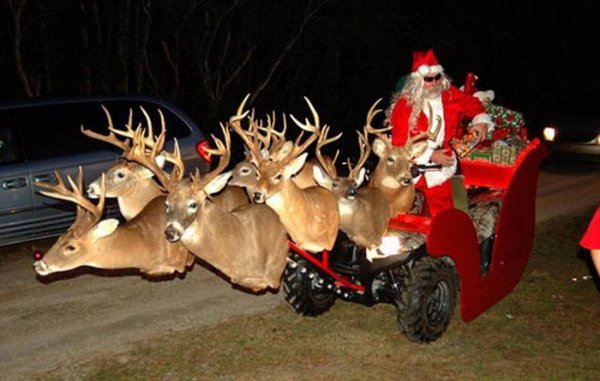 Redneck Christmas Float
Things They Wish They Could Retract … Or Maybe they Don’t.
Question: If you could live forever, would you and why?
'Whenever I watch TV and see those poor starving kids all over the world, I can't help but cry. I mean I'd love to be skinny like that,
but not with all those flies and death and stuff.'
'Smoking kills. If you're killed, you've lost a very important part of your life,'
'I've never had major knee surgery on any other part of my body,'
'Outside of the killings, Washington has one of the lowest crime rates in the country.'
'That lowdown scoundrel deserves to be kicked to death by a jackass, and I'm just the one to do it,'
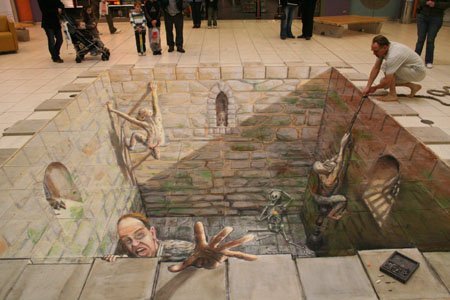 Drawn On A Flat Sidewalk With Colored Chalk.
THE UNSTOPPABLE VIRUS I thought you would want to know about this e-mail virus. Even the most advanced programs from Norton or McAfee cannot take care of this one. It appears to affect those who were born prior to 1960.
Symptoms: 1. Causes you to send the same e-mail twice. Done that!it is called the ‘C-Nile Virus’ Hmmm...Have I already sent this to you? |
|
|

